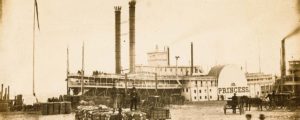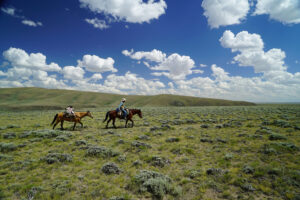Monstrous frontier freight wagons rumble still in Ketchum, Idaho.
Legendary Leviathans
Generations of Westerners have handed down stories of wooden leviathans that rumbled along the Santa Fe Trail in the 1840s. Joseph Murphy of St. Louis designed the massive wagons to carry freight—lots of freight—and they reportedly dwarfed other wagons of the era. But while the accounts are plausible, they are hard to substantiate, as Murphy’s shop records are missing.
Within a few decades, though, enormous freight wagons by numerous makers were indeed rolling down the dusty roads of the frontier West. Incredibly, in Ketchum, Idaho, a half dozen of these tall-sided 19th-century “freighters”—wagons seems too gentle a word to describe them—survive. “They’re an impressive example of just how big both the opportunities and challenges were on the 19th-century American frontier,” says Doug Hansen of Hansen Wheel and Wagon Shop [www.hansenwheel.com] in Letcher, S.D. His group of Western vehicle specialists recently researched, conserved and restored this exceptional collection of rugged transportation giants.
Freight Trains
The six Ketchum wagons turn 120 years old this year. The man behind these Goliath-sized conveyances was Idaho Territory freight line operator Horace Caleb Lewis (1858–1911). Lewis’ woodworkers and smiths built the freighters in 1889 to haul gold, silver and lead ore from rugged backcountry mines for his five-year-old Ketchum Fast Freight Line—“fast” being a relative term. The freighters followed a 180-mile route that took at least two weeks to complete—bringing supplies to the mines and returning with ore for the smelter in Ketchum, terminus of the Oregon Short Line Railroad.
A team of 16 to 24 mules and/or horses would pull a train of wagons linked in tandem. Such trains might stretch more than 200 feet, making for hair-raising turns on the steep, narrow paths. These outfits faced stomach-churning drop-offs, washed-out chasms, axle-deep mud and an array of weather, equipment and animal problems. What’s more, bandits often targeted the valuable cargo. It was not a job for the faint of heart. Strong men with even stronger resolve commanded the teams with single jerk lines and explosive vernacular until 1909.
Big Wheels
Given the hazards posed by Idaho mining country, it’s no wonder Lewis wanted big, brawny wagons for the job. Just how big are they? These voluminous vehicles boast 7-foot-tall rear wheels with 4-inch-wide steel rims, an overall height of 14 feet and an overall length of 16 feet. They weigh a road-crushing 6,400 pounds when empty, with a carrying capacity of close to 9 tons. They are comparable in weight to a full-size, heavy-duty pickup truck but can handle about four times the payload.
“These wagons are more than leftover transportation,” insists Hansen. “They’re fully functioning direct links to the rugged, independent spirit that built America. As a result, we concentrated on reinforcing the historic value and long-term viability of each wagon.”
Combined with a 20-mule hitch, the six surviving Lewis freighters are the major attraction each Labor Day weekend at Ketchum’s Wagon Days Festival [www.wagondays.com]. Drawing more than 20,000 people annually, the event pays tribute to the big wheels of Western freight lines.
Originally published in the October 2009 issue of Wild West. To subscribe, click here.




